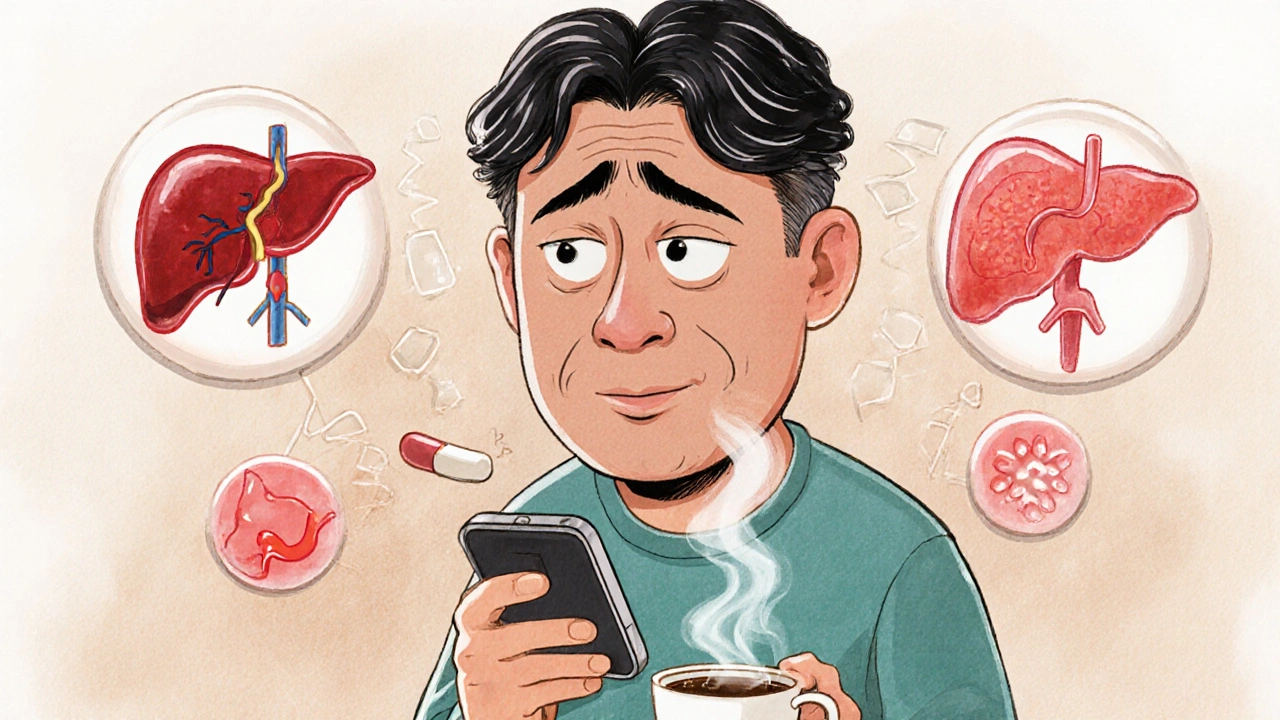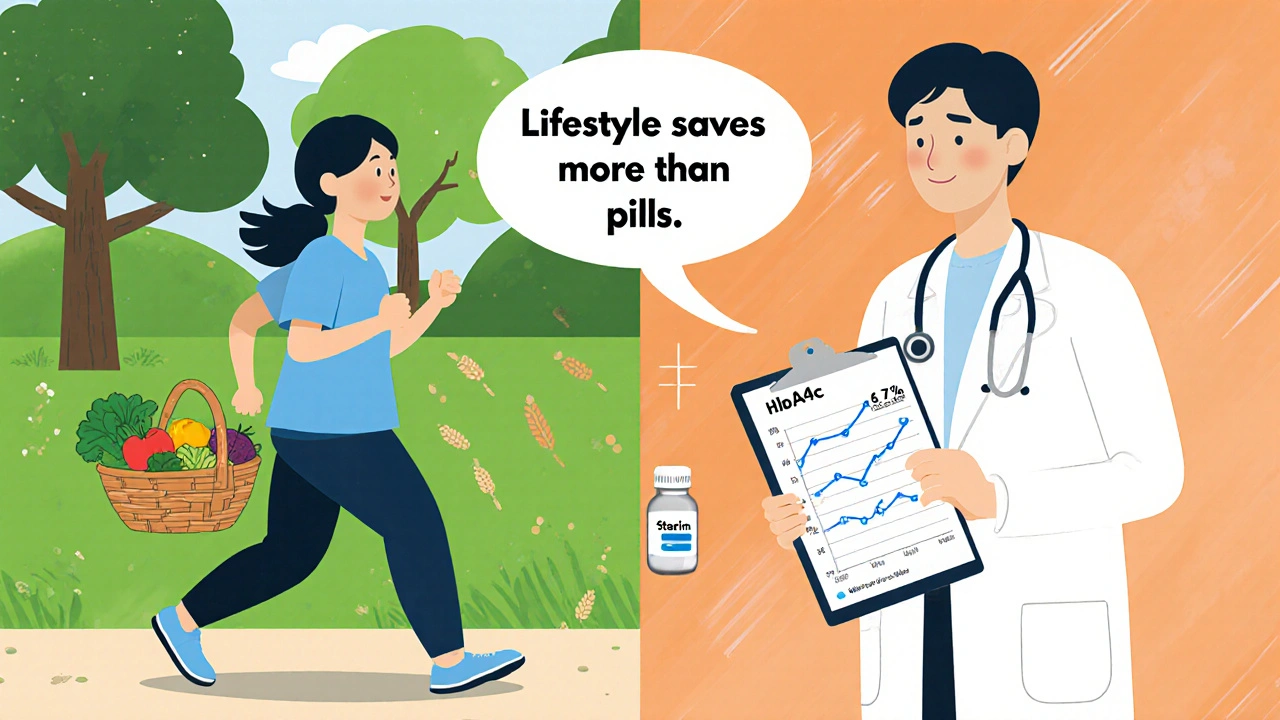
Statins Diabetes Risk Calculator
Personal Risk Assessment
This tool estimates your risk of blood sugar changes while taking statins based on evidence from clinical studies. Results are for educational purposes only and should not replace medical advice.
Your Risk Assessment
Many people take statins to lower their cholesterol and protect their heart. But if you’ve been on statins for a while, you might have noticed your blood sugar creeping up. You’re not imagining it. Research shows that statins can cause a small but real increase in blood sugar levels - enough to push some people with prediabetes into full-blown type 2 diabetes. It’s not common for everyone, but it’s real enough that doctors now monitor it.
How Statins Raise Blood Sugar
Statins work by blocking a liver enzyme that makes cholesterol. But that same enzyme is also involved in making other important molecules, like CoQ10 and isoprenoids. These help your muscles and pancreas work properly. When statins reduce them, your body’s ability to respond to insulin gets weaker. That’s called insulin resistance. At the same time, your pancreas tries to make more insulin to compensate. But over time, the beta cells in your pancreas get tired. They can’t keep up. That’s when blood sugar starts to climb.
A 2023 study of nearly 9,000 people in Finland found that those taking statins had a 46% higher chance of developing type 2 diabetes over six years. The reason? Insulin sensitivity dropped by 24%, and insulin production fell by 12%. Another study from Stanford showed that even 10 weeks of high-dose atorvastatin caused insulin resistance - and the body’s insulin response was already struggling to keep up.
Not Everyone Is Affected the Same Way
This isn’t a problem for everyone. If you’re young, lean, active, and your blood sugar is normal, your risk is very low. The real concern is for people who already have signs of metabolic trouble: belly fat, high triglycerides, low HDL, or prediabetes. In these cases, statins can be the final push that turns prediabetes into diabetes.
One big reason? Dose matters. High-intensity statins - like atorvastatin 40-80 mg or rosuvastatin 20-40 mg - carry the highest risk. Lower doses, like simvastatin 20 mg or pravastatin 40 mg, have much less impact. A 2021 analysis from Oxford found that people on high-dose statins had a 36% higher risk of developing diabetes compared to placebo. Those on lower doses? Just 10% higher.
What the Numbers Really Mean
It’s easy to panic when you hear "statins cause diabetes." But context matters. For every 1,000 people taking high-dose statins for five years, about 2 to 3 extra cases of diabetes might occur. That sounds scary - until you compare it to the benefits. In that same group, statins prevent about 15 major heart attacks or strokes. That’s five to seven times more people helped than harmed.
The American Heart Association and American Diabetes Association both agree: if you need a statin for heart protection, don’t stop it because of diabetes risk. The math still works in your favor. But that doesn’t mean you should ignore it. If you’re at risk, you need to be proactive.

Who’s Most at Risk?
Some people are more likely to see their blood sugar rise on statins. Look at these red flags:
- You have prediabetes (fasting glucose between 100-125 mg/dL or HbA1c 5.7-6.4%)
- You’re overweight, especially with extra fat around your waist
- You have high blood pressure or high triglycerides
- You’re over 65
- You’ve been diagnosed with metabolic syndrome
- You’re taking other drugs like steroids or certain antivirals
If any of these apply to you, your doctor should check your blood sugar before starting a statin - and again after 3 to 6 months. A simple fasting glucose or HbA1c test can catch early changes before they become a problem.
What You Can Do About It
Stopping statins isn’t the answer - unless your doctor says so. But there are things you can do to protect yourself:
- Move more. Just 30 minutes of brisk walking five days a week improves insulin sensitivity. You don’t need to run a marathon. Consistency beats intensity.
- Eat smarter. Cut back on sugary drinks, refined carbs, and processed snacks. Focus on vegetables, lean protein, whole grains, and healthy fats like olive oil and nuts.
- Watch your weight. Losing even 5-10% of your body weight can reverse prediabetes - and make statins safer.
- Get tested. Ask your doctor for an HbA1c test every 6 months if you’re on statins and have risk factors. Don’t wait for symptoms.
- Ask about your statin. If you’re on high-dose atorvastatin or rosuvastatin and have rising blood sugar, talk to your doctor about switching to a lower-intensity option. Sometimes, switching to pravastatin or fluvastatin helps without losing heart protection.
One woman from Birmingham I spoke with - a 62-year-old with high cholesterol and prediabetes - started on atorvastatin 40 mg. Six months later, her HbA1c jumped from 5.9% to 6.7%. Her doctor switched her to rosuvastatin 10 mg and added a metformin low dose. Her blood sugar dropped back to 5.8% within four months. She didn’t stop the statin. She just adjusted the plan.
What About People Who Already Have Diabetes?
If you already have type 2 diabetes, statins can make your blood sugar harder to control. Studies show HbA1c levels may rise by 0.1% to 0.3% on average - small, but enough to require medication adjustments. Atorvastatin seems to have a slightly stronger effect than other statins. That doesn’t mean avoid it. But it does mean your diabetes team needs to know you’re on a statin. They may need to tweak your insulin or oral meds.
Don’t assume your A1c is fine just because you’re taking diabetes pills. Statins can quietly undermine your progress. Regular monitoring is key.
The Bigger Picture
Statins are among the most studied drugs in medical history. Over 35 million Americans take them. In the UK, nearly 8 million prescriptions are written each year. The data is clear: they save lives. For people with heart disease, the benefit is massive. For those at high risk of heart attack or stroke - even if they’ve never had one - the benefit still outweighs the risk.
The diabetes risk is real, but it’s small. And it’s mostly preventable. The goal isn’t to avoid statins. It’s to use them wisely. That means knowing your risk, testing early, and making lifestyle changes before problems start.
What’s Next?
Scientists are now looking for genetic clues. Some people have a variation in the SLCO1B1 gene that makes them more likely to develop diabetes on statins. In the next few years, we may be able to test for this before prescribing. Until then, the best tools we have are simple: know your numbers, stay active, eat well, and talk to your doctor.
Statins aren’t perfect. But they’re one of the most effective tools we have to prevent heart disease. The key isn’t fear. It’s awareness. If you’re on statins, don’t assume your blood sugar is fine. Check it. Adjust your habits. Work with your team. That’s how you protect your heart - without trading it for diabetes.
Do statins cause diabetes?
Statins don’t directly cause diabetes, but they can raise blood sugar levels enough to push some people with prediabetes into full diabetes. This happens in a small percentage of users - mostly those already at risk due to weight, genetics, or metabolic issues. The risk is higher with high-dose statins like atorvastatin or rosuvastatin.
How much does statin use increase diabetes risk?
For people on high-intensity statins, the risk of developing diabetes increases by about 36% compared to placebo. For lower doses, the increase is around 10%. In absolute terms, that’s about 1 extra case of diabetes per 100 people taking statins for 5 years. But over the same period, statins prevent 15 major heart events in that same group.
Should I stop taking statins if my blood sugar rises?
No - not without talking to your doctor. Stopping statins increases your risk of heart attack or stroke far more than the risk of diabetes. Instead, work with your provider to adjust your treatment. You might switch to a lower-dose statin, add metformin, or improve your diet and exercise. Most cases of statin-related blood sugar rise can be managed without stopping the medication.
Which statins are least likely to raise blood sugar?
Pravastatin and fluvastatin have the lowest association with blood sugar increases. Atorvastatin and rosuvastatin - especially at high doses - carry the highest risk. If you’re at risk for diabetes, your doctor may choose a lower-risk statin or a lower dose. Never switch on your own.
Can lifestyle changes reduce the diabetes risk from statins?
Yes - and this is the most important point. Losing weight, eating fewer refined carbs, walking daily, and getting enough sleep can reduce insulin resistance and help your body handle statins better. In fact, lifestyle changes can completely offset the small diabetes risk from statins for many people. Medication isn’t the only tool - your daily habits matter just as much.
12 Comments
Write a comment
More Articles

Generic Pill Appearance Changes: What You Need to Know About Safety, Legality, and Patient Risk
Generic pills can change color, shape, or size without affecting safety-but these changes cause many patients to stop taking their meds. Learn why it happens, what drugs are affected, and how to stay safe.

Why Everyone Should Be Talking About Stone Root: A Revolutionary Dietary Supplement
I recently came across a revolutionary dietary supplement called Stone Root, and I think everyone should be talking about it. It's a natural herb with numerous health benefits, such as improving digestion, reducing inflammation, and even helping with kidney stones. Many people are unaware of this amazing supplement and its potential to improve our overall health. As a blogger, I feel it's my duty to spread the word about this incredible discovery. So, let's get the conversation started and explore the wonders of Stone Root together!

6 Effective Alternatives to Lamotrigine in 2025
Exploring alternatives to Lamotrigine in 2025, this article highlights various options for treating epilepsy, bipolar disorder, and migraines. It covers the benefits and drawbacks of each alternative, providing insights into the pros and cons of medications like Valproate, known for its wide efficacy and particular risks. Readers will gain informative guidance to navigate treatment options tailored to their condition.
Kihya Beitz
November 16, 2025 AT 03:23So let me get this straight - we’re telling people to take a drug that *might* nudge them into diabetes, but hey, at least their heart won’t drop dead? Sounds like a传销 scheme if I ever heard one. 🤡